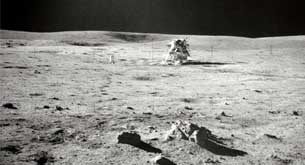Facts about the Moon
Posted by Admin / in Science Facts
The moon is important to the Earth. Our oceans are effected by the pull of the moon. We can see better at night when the moon is in view. We have also based our calender on the moon's orbit around the Earth. The moon as we know it, is the Earth's one and only moon. Some planets have more than one more. For example, NASA scientists officially consider Saturn as the planet with the most moons (53 moons), although Jupiter may have more. Some newly discovered moons around Jupiter are still being verified by NASA. Find out more interesting facts about the moon.

The amount of moon we see at night is based on the moon's location compared to the sun.
Photo Credit: nasa.gov
Interesting Facts about the Moon
- The average distance from the Earth to the moon is approximately 239,000 miles (384,000 km).
- If there was a highway connecting the Eath and moon. A car traveling 65 mph (104 km/hr) would take over 153 days to travel from Earth to the moon!
- The moon is the Earth's only natural satellite (object that rotates around a planet).
- The moon has no atmosphere. There is no air or protection from meteors on the moon. There is also no protection from solar radiation. UV rays, gamma rays and x-rays, which the Earth's atmosphere help filter, are at high levels on the surface of the moon.
- The temperature of the moon varies much more than Earth. High temperatures reach 230 degrees Fahrenheit (104 degrees Celsius), which is hotter than boiling water. Night temperatures are equally harsh. Low temperatures go down to -279 degrees fahrenheit (-173 degrees Celsius). There is no atmosphere on the moon to keep in the heat or protect the surface from the sunlight.
- Gravity on the moon is 83.3 percent less than on the moon. A person who weighs 100 pounds (45.4 kg) on Earth, only weighs 16.6 pounds (7.5 kg) on the moon.
- The light we see from the moon is actually reflected light from the sun.
- Gravity pull from the moon effects the Earth's oceans, resulting in tides.
- The same side of the moon always faces the Earth! This is why people call the other side of the moon the "dark side of the moon". This side of the moon is not always dark. People on Earth cannot see the other side of the moon from the Earth.
- The moon orbits (circles around) the Earth. One complete rotation takes just under 28 days.
- The length of a day on the moon is also just under 28 days. If you were standing on the moon a day would have 345 hours of light and 345 hours of night. The rotation of the moon is timed with its orbit around the Earth so the same side of the moon is always facing the Earth.
- The surface of the moon contains has mountains, plains and valleys. All of these features were created by asteroids hitting the surface of the moon.
- The surface of the moon is made up of volcanic rock and dust. Scientist think the powdery dust is material that blew out from the moon's surface when meteorites have hit the moon.
- Scientists now believe there is some water under the surface of the moon. When the Apollo astronauts took moon rock and soil samples, the samples showed trace amounts of water in the samples. At the time, the scientists thought the moon samples were contaminated. Recent unmanned moon missions have now provided some evidence that there is water under the moon's surface.
- There is no life on the moon.
- The first spacecraft to orbit the moon was Apollo 8. This was a spacecraft from the United States launched on December 21, 1968. The crew of Apollo 8 was Frank Borman, James Lovell, Jr., and William Anders. They traveled in a Saturn V rocket from the Earth and orbited the moon. The crew then returned safely to Earth.
- There have been 6 manned spacecraft landing on the moon. All the spacecraft were from the United States. No manned landings on the moon have occurred since 1972. The last mission to the moon was Apollo 17 from December 7-19, 1972. Astronauts Commander Eugene Cernan and Harrison Schmidtt spent more time exploring the surface of the moon during this mission than any astronauts before them.
- The first person to step foot on the moon was Neil Armstrong from Wapokeneta, Ohio on July 21, 1969.
- A total of 12 men safely landed on the moon and returned to Earth from 1969 to 1972. The 12 astronauts that walked on the moon include Commander Neil Armstrong and Buzz Aldrin (Apollo 11), Alan Bean and Commander Charles Conrad (Apollo 12), Commander Alan Sheppard and Edgar Mitchell (Apollo 14), Commander Donald Scott and James Irwin (Apollo 15), Commander John Young and Charles Duke (Apollo 16) and Commander Eugene Cernan and Harrison Schmidtt (Apollo 17). Eugene Cernan was the last man to step foot on the moon.
- The first spacecraft to crash into the moon from the Earth was the Luna 2 spacecraft from the Soviet Union in 1959.
Space Travel to the Moon

Image of the lunar surface.
Photo Credit: nasa.gov

Buzz Aldrin planting the U.S. flag in the moon during the Apollo 11 mission.
Photo Credit: nasa.gov
